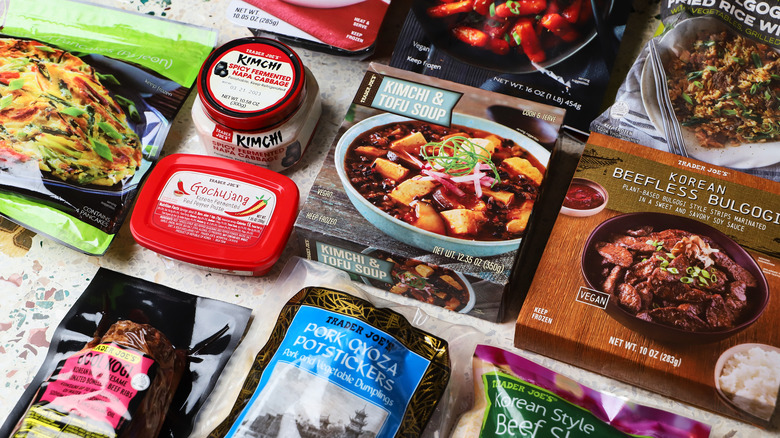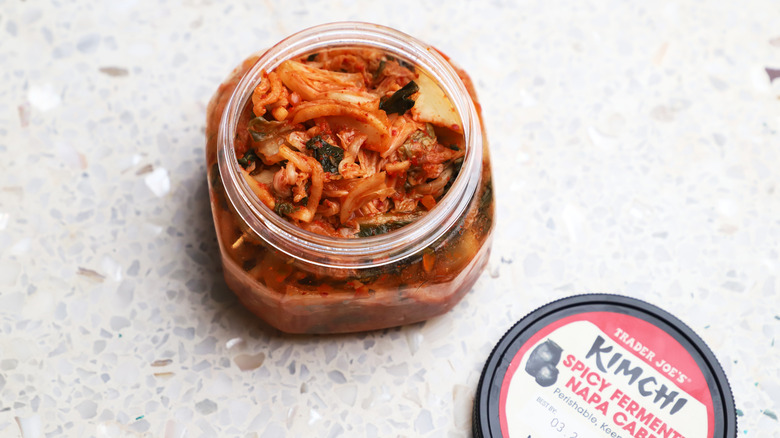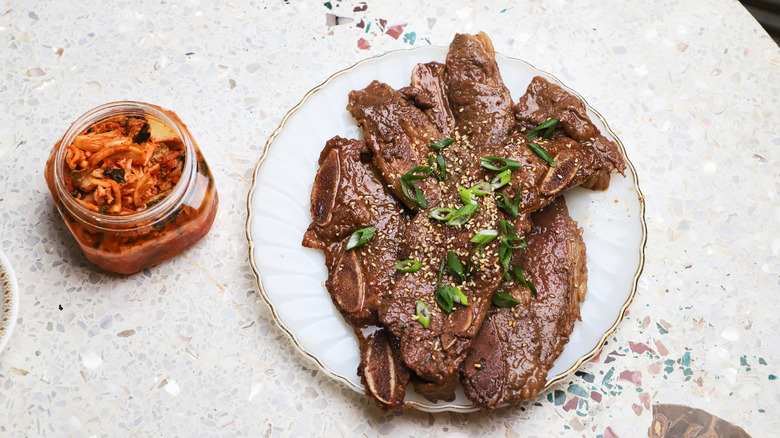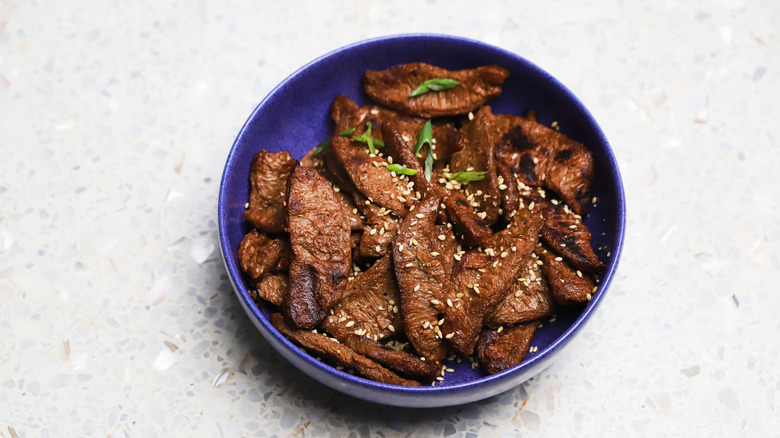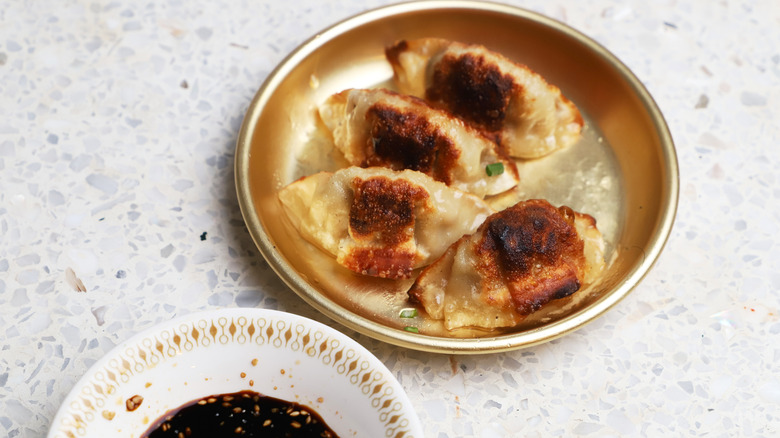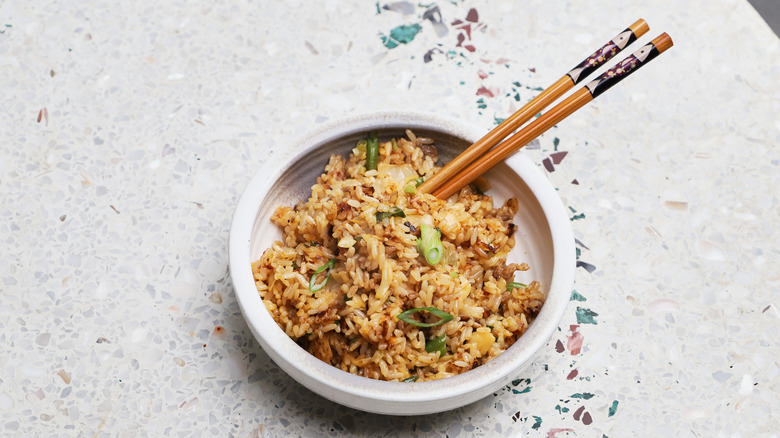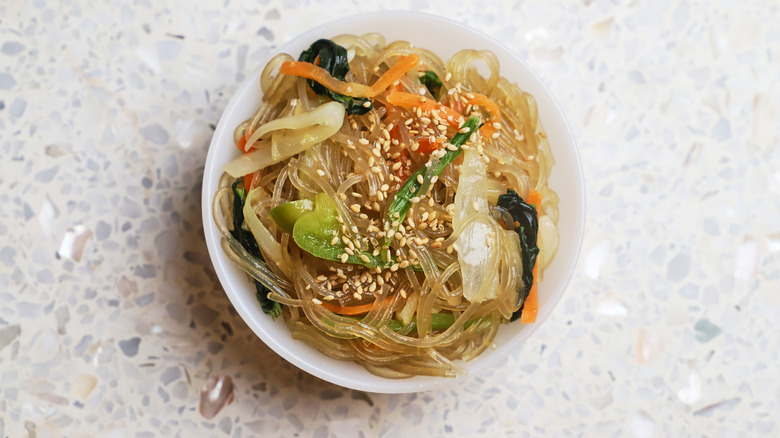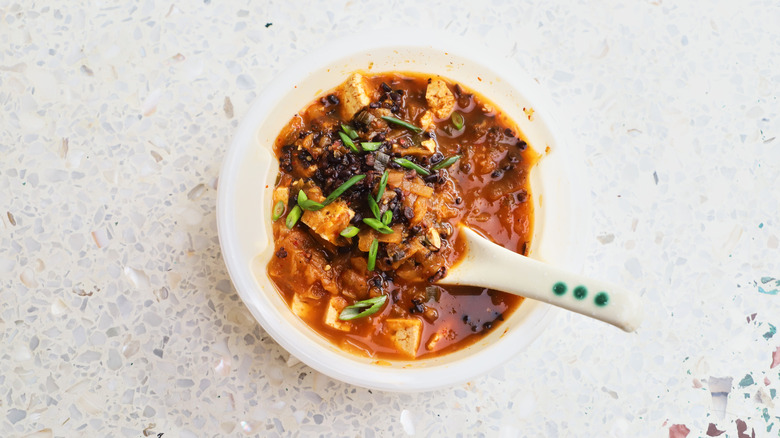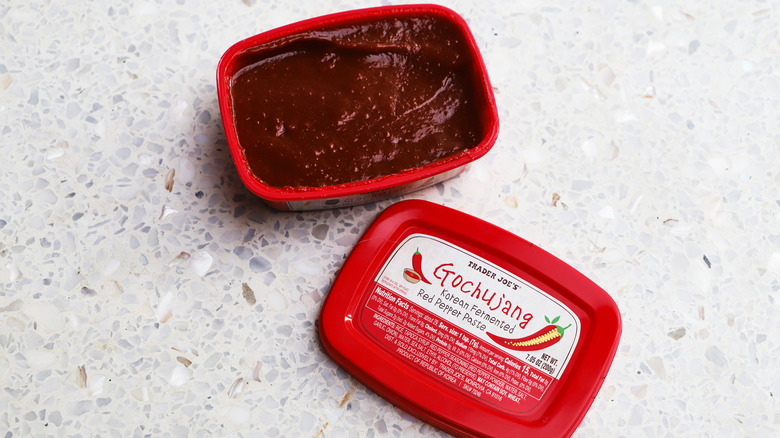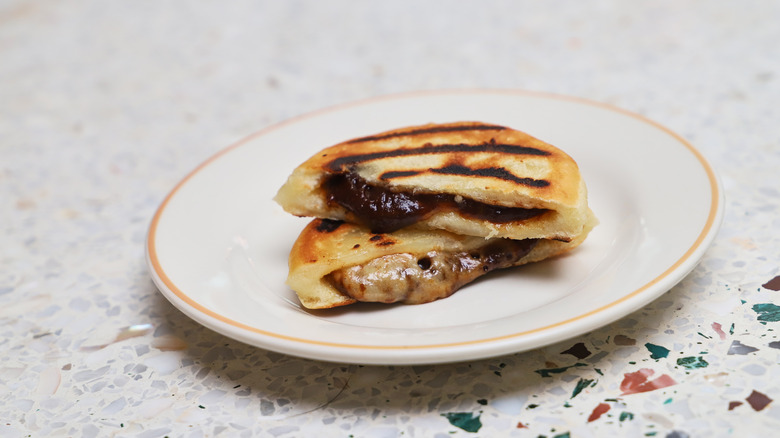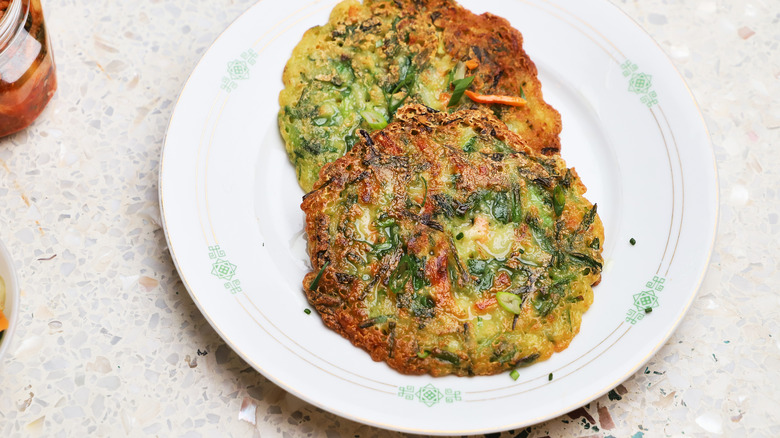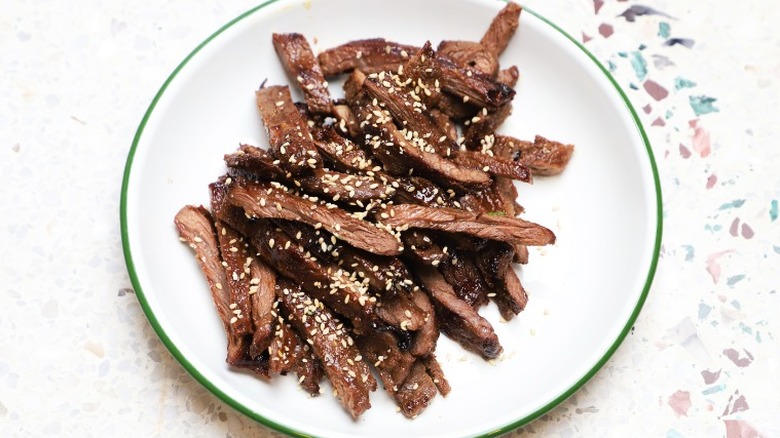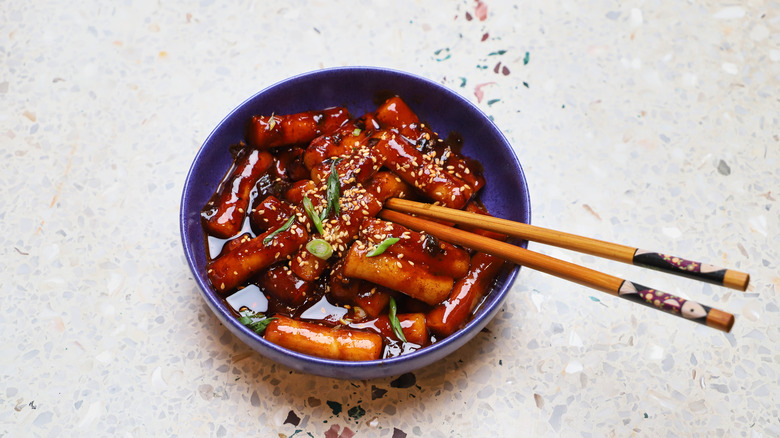Every Korean Food At Trader Joe's, Ranked Worst To Best
While we're no strangers to the chipper, bell-chiming Trader Joe's aisles, the store's expanding Korean-inspired offerings now dot its shelves from the freezer section to the pantry staples with items like tteokbokki (also sometimes spelled ddukbokki), gochujang, and perhaps the most well-known Korean food in the world, kimchi.
Thankfully, these new additions to the Monrovia, Californian-based grocery chain outdate the brand's past practice of labeling non-American items with harmful, stereotypical titles (according to Forbes) like "Trader Ming's" to denote Chinese products, "Trader Giottos'" for Italian goods like pasta and marinara sauce, "Arabian Joe's" to signal its Middle Eastern-influenced line of hummus and tabouli, and so on. Otherwise, we may be fastening our chopsticks to a noodle squeamishly dubbed Trader Kim's — or worse.
Instead, the only offense these Korean-influenced offerings are guilty of is under-seasoning and sogginess, a crime rampant in the bountiful freezer section that spans from the wildly popular Trader Joe's frozen shrimp to desserts. So, to establish a pecking order of Korean-ish dishes and ingredients, we loaded up one of the store's bright crimson baskets with bulgogi, dumplings, japchae, and more to test drive how the Korean leaning items stack up against the classic Korean dishes we're accustomed to.
12. Kimchi
Blink, and you might miss Trader Joe's 10-ounce plastic mini-jar of kimchi hiding alongside the store's hummus, cheeses, and "fresh" pasta selection. The first sign something may be amiss is how Trader Joe's squat kimchi container holds only two to four approximate servings of Korea's most popular food. Like most store-bought kimchi, Trader Joe's entry into the cannon opts for Napa cabbage (or baechu kimchi) but also includes bits of white onion and shredded daikon radish, which consistency-wise felt a little odd and discordant.
Typically found in economy-sized jars in Korean households, the minuscule Trader Joe's varietal lacks both a healthy amount of the kimchi liquid we love to pour over rice and any texture left in the Napa cabbage. Quixotically dry and soggy, TJ's kimchi also is woefully under-salted and omits any fish or shrimp products classically found in various types of kimchi — great for our vegan and vegetarian friends but lacking for anyone acquainted with a more flavorful version of the fermented food. However, we will admit that the kimchi does boast a noticeable amount of spice, and while still fairly mild overall, we were left with a zingy tingle lacing our tongues after plucking cabbage bits from the undersized container.
11. Korean Style Beef Short Ribs
One of the more ambitious Korean-ish items from Trader Joe's catalog is its marinated short ribs (or galbi), found in the frozen foods section of the grocery store. Double-sealed in two plastic bags (one containing a simple marinade the ribs have been submerged and frozen inside), Trader Joe's bone-in short ribs must be defrosted before preparing and come in 20-ounce portions (about six slices).
Once thawed, the preparer is asked to heat a skillet over medium-high heat and sautee the ribs for three to four minutes per side. We tipped the remaining marinade into our cook pan for an extra saucy and (hopefully) flavorful plate of red meat. Though the ribs boast galbi's signature tenderness, the sweet and salty intermingling was noticeably turned down in Trader Joe's version.
Containing soy sauce, brown sugar, rice wine, garlic, and (oddly) lemon juice, the store-bought ribs fall short of satisfying cravings for the cornerstone of Korean bbq and could use a double dose of sugar or a shredded apple for an extra boost of sweetness. The meat also possessed a slight tinge of freezer burn toward each bite's final notes, which left the experience feeling artificial and uncanny.
10. Korean Beefless Bulgogi
The only imitation meat among Trader Joe's Korean items arrives in a pouch of marinated, plant-based protein intended to mimic the qualities of bulgogi — or a sweet, BBQ beef dish popular in Korea and found at most Korean restaurants in the U.S. Admittedly, the phony beef does resemble the real thing down to its ability to char along the edges, and aside for the nuggets being unsettlingly springy to the touch and uniform to the naked eye, the beefless bulgogi visually succeeds at portraying a convincing plate of meat.
Once chewed, however, the true origins of the beefless bulgogi beings to show; at once both rubbery and stringy, the soy-based "beef" broke down too easily between our teeth, and we were never able to shake the eerie experience of manufactured meat. Though while we rather enjoy a plate of vegetables, tofu, or a meatless meal not mimicking meat, for our vegetarian friends yearning for a bite of beef, TJ's Korean Beefless Bulgogi is seasoned well with noticeable ginger, sugar, and green onions notes.
9. Pork Gyoza Potstickers
Dumplings populate a substantial chunk of Trader Joe's frozen food section. As guests gaze down at the array of dough-encased offerings, sifting through the pile of options and finding the store's pork and vegetable dumplings (the most Korean-inspired of its dumpling creations) proves the most challenging task. That is until trying to eat these surprisingly simple to-make dumplings.
Though the blue bag is labeled both gyoza (the Japanese term for dumpling) and potsticker (the Chinese wording for the same dish), Korea's verbiage (mandu) is omitted from the packaging. Still, we're including the pork and veggie dumplings in our rundown due to the overwhelming similarity between the dishes and the essentialness of dumplings in a Korean feast.
Unlike most items on this list, Trader Joe's pork and vegetable dumplings include several different cooking instructions (microwave, steamed, pan-fried, and boiled in soup) — we opted for pan-fried since this preparation remains our favorite when we dine out.
More than most store-bought dumplings, Trader Joe's cooked up nicely and didn't contain any symptoms of freezer burn; though since the bag of dumplings doesn't include a sauce of any kind, we whipped up a simple dip of soy sauce, rice vinegar, garlic, and sesame seeds (all of which can also be found within the walls of a Trader Joe's). However, the promise of the dumpling skins quickly evaporates since the cooked farce tastes startingly Western, more akin to a meatball than the insides of any Asian dumpling we've enjoyed.
8. Bulgogi Beef Fried Rice with Kimchi
Though creating a kimchi fried rice from scratch is nowhere within the realm of difficulty, it can admittedly be an effort we're not always in the mood to complete. Trader Joe's, no stranger to fried rice of all kinds, tosses a Korean entry into its mountain of pre-made, rice-based meals via bulgogi beef fried rice with kimchi.
Our fried rice cooked up impressively well in a wok heated to medium-high and coated with a thin layer of vegetable oil. We even succeeded in charring little crunchy bits of rice just like our favorite restaurants always do.
The main issue was the dearth of actual kimchi pieces — or any spicy, tangy, sweet kimchi flavor. Instead, the fried rice felt like a subtle Korean-ified reworking of the grocery store's existing Chinese-leaning fried rice. The presence of green beans (not an impossible but somewhat unlikely inclusion) further backs up this critique along with the pale shade of the frozen rice, which we wish were hued the orange/red that signals a substantial amount of gochujang in the mix.
Either way, if you decide to take home your own bag of TJ's Korean fried rice, we can't overstate how much you'll benefit from a non-stick pan and a sunny side egg to crown your meal.
7. Japchae
Made of thin, glass-like noodles, japchae, a simple banchan served alongside meats and other small plates, is one of the simplest Korean dishes to make — even without the help of Trader Joe's Korean food line. So TJ's microwavable interpretation seems superfluous, especially once we opened the jarringly stiff and opaque noodle mixture and confronted the sad plastic tray Trader Joe's asks you to microwave for just three minutes.
Shockingly, once nuked, the sweet potato noodles are restored to the slick and clear texture japchae is known for, though the remainder of the noodles stays dry and under-seasoned. Also, since Trader Joe's opts to offer an entirely vegan variation of this banchan (which often contains slices of leftover beef and egg ribbons), there's a level of excitement and vivacity missing from the translucent noodles.
Another odd omission is that of sesame oil in favor of onion-infused canola oil. But, since the japchae was bland overall, we drizzled a tablespoons worth of our preferred cooking oil atop the noodles to help bolster the blandness of soggy carrots, spinach, and (strangely) bell peppers.
6. Kimchi and Tofu Soup
Another vegan rendering of an essential Korean dish, Trader Joe's attempts to recreate soondubu or a soup made from kimchi, tofu, and spicy Korean peppers. Packaged as a single serving ready for the microwave, Trader Joe's takes a comforting Korean stew and atomizes the classic dish into a solo dining option from home.
While the broth does contain a pleasurable interplay of sour and spice, the overall flavor was much closer to Chinese sweet and sour soup than the hearty soondubu jjigae we crave during cold days. Plus, the inclusion of black rice is confounding, too toothsome, and left us missing the soft cushion of sticky white rice with every bite.
That said, the overall experience was adequate despite the lack of steamed white rice, oyster or fish sauce, a runny egg, and a softer, more wispy tofu. Inauthentic from top to bottom, we reminded ourselves of the culinary origins of instant ramen and decided to embrace Trader Joe's Kimchi and Tofu Soup for what it was — a low-caloric, passable but underwhelming meal we'll eat again.
5. Gochujang
One of the items we're happiest to see along the aisles of Trader Joe's is its branded gochujang, or Korean fermented chili pepper paste. Our slight fervor derives not from the promise of the Californian company's capability to create a formidable gochujang but rather from the prominence of the ingredient in Korean kitchens and its exposure to the general public through its availability at conventional groceries.
Like in the petit jar of kimchi, we first took in the modest size (7-ounce) of TJ's gochujang (an average size container at H-Mart weighs a little over two pounds), which would feasibly be drained by hosting just one Korean feast. After unsealing the package, the paste looked fairly familiar, if not slightly lighter in color than our go-to carton of Sing Song Gochujang.
After a whiff, we noticed a somewhat yeasty tinge to the nose of the sauce that, after inspecting the ingredient list, we assume comes from the prominence of tapioca (not present at all in Sing Song). Whatever the case, the whisper of a dull pull was also present on the tongue, probably from the manufacturer (gochujang is often diluted). Overall, though, the sauce itself holds rank with TJ's other knock-off hot sauces, like its renditions of sriracha and Tabasco.
4. Sweet Cinnamon Filled Korean Pancake
At once the most unlikely and most viable of all of Trader Joe's Korean creations, the sweet cinnamon-filled Korean pancake (or hodduk) is probably the Korean dish most unfamiliar to the Western world. However, hodduk (like dumplings) is a staple of Korean grocery stores like H-Mart, and like the savory counterpart, the frozen version satisfies quick cravings fairly well.
But unlike mandu, hodduk cannot easily be found homemade at local Korean restaurants and food stalls, and the frozen form of the sweet snack (in the states, at least) is the most commonly encountered variant of the dessert. Moreover, creating a homespun hodduk would no doubt be a dough requiring commitment. So, despite the hodduk's relative (we're assuming) obscurity to most Trader Joe's shoppers, it also makes the most sense as a frozen food item at a market dedicated to pre-made delights.
Like we hoped for, Trader Joe's take on the Korean pancake impressed us — filled with gooey cinnamon filling, we opted to pan fry our hodduk (there are also microwave instructions). The dough took on the grill marks of our pan and grew pleasurably crunchy on the exterior while remaining soft and pillowy inside its quesadilla-like casing. We wish TJ's offered a sweet, red bean paste (or pat ang geum) rendering of the frozen pancake, but for now, we appreciate the cinnamon-filled pastry for all its glory.
3. Scallion Pancake
One of the more suspicious Korean-influenced items at Trader Joe's proved to be one of the store's more formidable. Found in the freezer section in a large, resealable plastic bag, Trader Joe's Scallion Pancake (or pa jeon) arrives in your home frozen and pre-formed into four individual CD-sized spheres.
Completely vegetarian (though not vegan), the pancakes contain wheat flour, onion, leek, scallion, oyster mushrooms, and egg. Aside from the microwavable dishes on this list, Trader Joe's pa jeon proved to be the simplest to prepare; a quick couple minutes per side in an oil-slicked frying pan and the pancakes cook to a delightful crisp outer layer and a soft, chewy (though not doughy) center.
Like with the dumplings, we mixed up a simple dipping sauce for the pancakes made of rice vinegar and soy sauce, then garnished our pancakes with fresh scallions (which only some Trader Joe's carry. Otherwise, the dish feels insipid and incomplete. Overall, the pa jeon outperformed our meager expectations by miles and might make its way into our home freezer whenever we don't want to gather the ingredients to make a homemade scallion pancake recipe.
2. Bool Kogi
Despite the odd and inconsistent spelling of bulgogi (we can't, in seriousness, use the company's spelling), Trader Joe's manages to finally nail the Korean beef dish. Gladly so, as nearly half of its Korean-influenced items riff on it. Unlike the bone-in short ribs, imitation meat, and fried rice bowl, this bulgogi can be found away from the treasure trove of frozen goods and at the more reliable meat counter.
Plastic-wrapped in a sesame-based marinade, the boneless short ribs are trimmed into approximately six strips of lean, thinly sliced meat. The packaging initially confused us; the seal hugs the meat so tightly that it looks like you're buying a mini-pot roast instead of several strips of meat.
Though the cooking instructions encourage their preparer to "fire up the grill" and kiss each side of the short ribs for around five minutes on an outdoor cooker, we fried ours on a grill pan for the suggested time, allowed the beef to rest for five minutes and then cut it into bite-sized sticks.
Originally dubious of a Trader Joe's marinade, its unfrozen bulgogi shines as the flavors meld in a sweet finish that, to be perfectly honest, is better than any other Trader Joe's meat or seafood item we've ever taken home. While it needs a bowl of rice, ssamjang, and fresh lettuce to fully rise to its potential, we see ourselves skipping an extra step in assembling a Korean BBQ spread in the future and leaning on this bargain convenience.
1. Tteok bok ki
Like the popular Trader Joe's frozen gnocchi, the christened teok bok ki (or ddukbokki) just makes sense. Even from scratch, the meal is easy, filling, and incredibly satisfying. Rice cakes called dduk, or tteok, are cooked and coated with a thick, syrupy, gochujang-based sauce; the popular Korean dish can be found in food stalls around Korean nightlife. The ease of replicating a spicy tteokbokki recipe at home makes this a promising dinner for Trader Joe's to corner.
Unlike the tteok we're accustomed to bringing home from our Asian grocery, TJ's rice noodles are pre-boiled and soft upon opening. After a quick 15-minute soak in cold water, they're ready to simmer in a saucepan and covered in the crimson sauce packet. We allowed the rice cakes to continue to simmer in the sauce for an additional two minutes past the suggested cook time, creating an even more viscous sauce and rice cakes that developed a slight crust along the ends.
Visually and on the tastebuds, Trader Joe's executes its teok bo ki to the closest approximation of the real thing when compared to its other Korean-inspired dishes; and just like all our other favorite TJ's take-home dinners, the rice cakes in sauce vibrate in the guilty pleasure vein that we appreciate the chain store for most.
